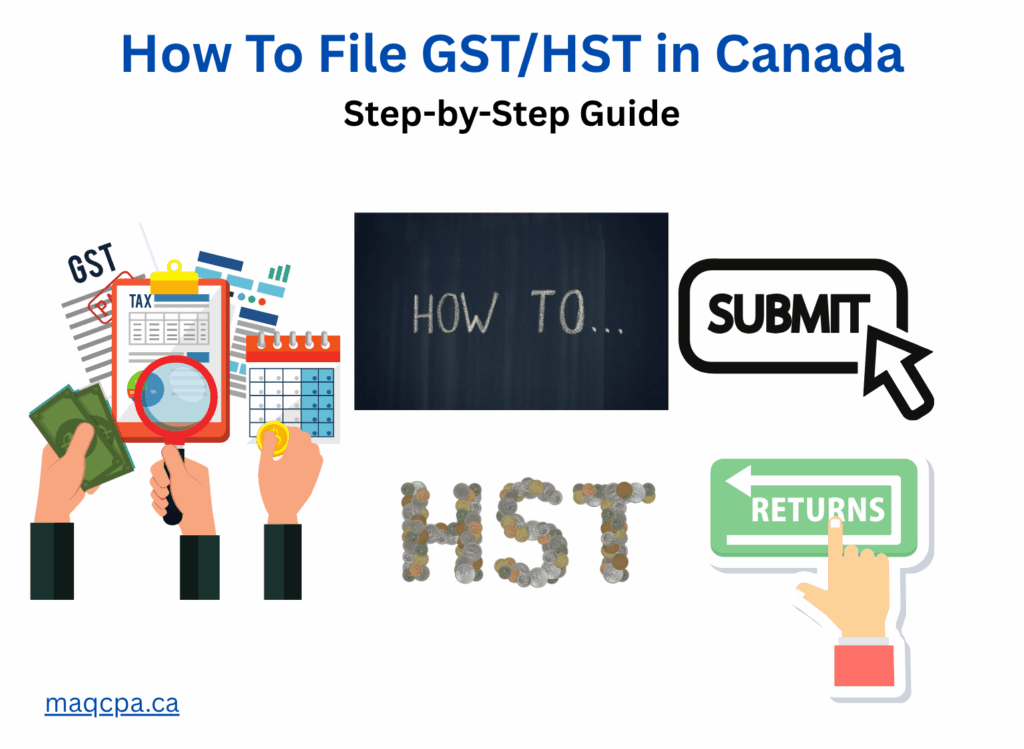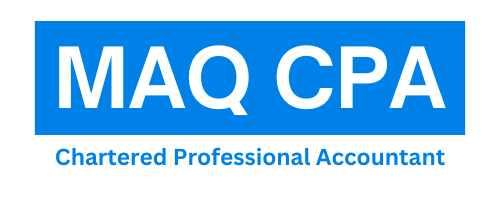If you’re a small business owner in Canada and you’re registered for GST/HST, then filing your return is a legal requirement, even if you earned no revenue. By the time you finish reading this article, you should learn how to file gst/hst in Canada.
For many entrepreneurs, freelancers, and consultants, this process can feel intimidating. What numbers go where? What do I actually owe? How do I avoid CRA penalties?
Don’t worry. We’ll guide you step-by-step with a real-life example, a complete net tax calculation, and a sample return just like what you’d file online.

Key Takeaways
- You must file GST/HST returns for every period assigned to you, even with $0 revenue.
- The return shows GST/HST collected, minus eligible Input Tax Credits (ITCs).
- Filing can be done online, by mail, or via your tax accountant.
- A real example will show how to calculate the net tax you owe.
- CRA penalties apply for late or missed returns, so timely filing is crucial.
Who Needs to File GST/HST?
You must file if:
- You’re registered for GST/HST
- Your taxable sales exceeded $30,000 over four quarters, or
- You voluntarily registered before hitting the threshold
Even if you didn’t collect any GST/HST in a period, CRA still expects a nil return.
Example: Meet Sarah, Toronto-Based Consultant
Let’s break it down with a real-world scenario:
Business Name: Sarah’s Consulting Co.
Business Type: Sole Proprietor
Location: Toronto, ON
Industry: Marketing & Business Consulting
Filing Frequency: Quarterly
Reporting Period: January 1 – March 31, 2025 (Q1)
📊 During this quarter, Sarah had:
- Sales: $20,000 (all taxable at 13% HST in Ontario)
- HST Collected: $20,000 × 13% = $2,600
- Business Expenses with HST:
- Office Rent: $1,130 (HST portion: $130)
- Business Laptop: $1,695 (HST portion: $195)
- Software Subscriptions: $452 (HST portion: $52)
- Online Ads: $1,130 (HST portion: $130)
- Legal Fees: $1,695 (HST portion: $195)
- Office Rent: $1,130 (HST portion: $130)
💰 Total ITCs (Input Tax Credits) = $130 + $195 + $52 + $130 + $195 = $702
Step 1: Understand Your Filing Frequency
Because Sarah earns less than $1.5 million in annual taxable revenues, she can choose annual, quarterly, or monthly filing. She selected quarterly to better manage cash flow.
Her CRA-assigned filing period is:
➡️ January 1 to March 31, 2025
➡️ Filing & Payment Due: April 30, 2025
Step 2: Calculate Net Tax (GST/HST Owed)
Here’s how Sarah calculates what she owes to the CRA:
GST/HST Collected:
✅ $2,600 (from $20,000 in sales)
Input Tax Credits (ITCs):
✅ $702 (from eligible business purchases)
Net Tax Owed = $2,600 – $702 = $1,898
Sarah must remit $1,898 to CRA by April 30, 2025.
Step 3: File Your GST/HST Return to CRA
Sarah logs into her CRA My Business Account and navigates to the GST/HST program.
She selects:
- Return period: Jan 1 – Mar 31, 2025
- Form: GST34 (for regular returns)
She fills in the required fields (see sample below), submits the return, and saves the confirmation number.
Step 4: Remit the Balance or Claim a Refund
Because Sarah’s net tax is positive ($1,898), she must remit this amount to CRA.
She pays online by:
- Logging into her online banking
- Adding “CRA – GST/HST” as a payee
- Using her 15-digit GST/HST account number (e.g., 123456789RT0001)
CRA confirms payment instantly via My Business Account.
Sample GST/HST Return – Line-by-Line Walkthrough
Let’s simulate what Sarah’s online return looks like:
| Line # and Description | Amount |
| Line 101 Sales and other revenue | 20,000 |
| Line 103 GST/HST collected or collectible | 2,600 |
| Line 104 Adjustments (Sales) | – |
| Line 105 Total GST/HST and adjustments for period | 2,600 |
| Line 106 Input tax credits (ITCs) | 702 |
| Line 107 Adjustments (Purchases) | – |
| Line 108 Total ITCs and adjustments | 702 |
| Line 109 Net Tax | 1,898 |
| Line 110 Instalments and other annual filer payments | – |
| Line 111 Rebates | – |
| Line 112 Total other credits | – |
| Line 113A Balance | 1,898 |
| Line 205 GST/HST due on acquisition of taxable real property | – |
| Line 405 Other GST/HST to be self-assessed | – |
| Line 113B Total other debits | – |
| Line 113C Balance | 1,898 |
Sarah hits Submit, and her GST/HST return is now officially filed.
Common Mistakes to Avoid
| ❌ Mistake | ✅ How to Avoid |
| Forgetting to file a nil return | Set calendar reminders; use a checklist |
| Overclaiming ITCs | Keep itemized receipts, log personal use |
| Missing the deadline | File early or automate with a CPA |
| Using wrong GST/HST rate | Verify rate by province via CRA site |
| Not keeping records | CRA requires 6 years of documentation |
FAQ
1. What if I can’t pay the full amount right away?
Still file on time to avoid late-filing penalties. Then contact CRA to arrange a payment plan.
2. Can I claim ITCs if I voluntarily registered for GST/HST?
Yes. As long as your purchases are for commercial activities, you can claim ITCs even before hitting the $30,000 threshold.
3. Do I have to file even if I earned no income?
Yes — CRA still requires a nil return for every assigned filing period.
4. How long should I keep my GST/HST records?
Minimum six years after the end of your tax year.
Final Words
Filing GST/HST doesn’t have to feel like pulling teeth. As Sarah’s example shows, with the right tracking and tools, the process is simple, accurate, and 100% manageable.
Whether you’re just starting out or growing your business, proper GST/HST filing protects your business, builds CRA compliance history, and lets you recover business expenses through ITCs.
📞 Need a hand with your GST/HST filing? Our Small Business Bookkeepers specialize in working with small businesses, startups, and professional corporations across Canada.
Book a consultation — and let us help you file with confidence.
Read our GST/HST return filing services.
Disclaimer
The information provided in this blog is for general informational purposes only and does not constitute professional accounting, tax, financial, or legal advice. While we strive to ensure the accuracy and timeliness of the content, the information may not apply to your specific situation or reflect the most current legislative changes. Readers are strongly advised to consult a qualified professional before making any decisions based on the content of this blog. MAQ CPA and its representatives disclaim any liability for any loss or damage incurred as a result of reliance on any information provided herein.
